Rebecca Eanes's Blog, page 11
July 23, 2015
3 Steps to Positive Discipline
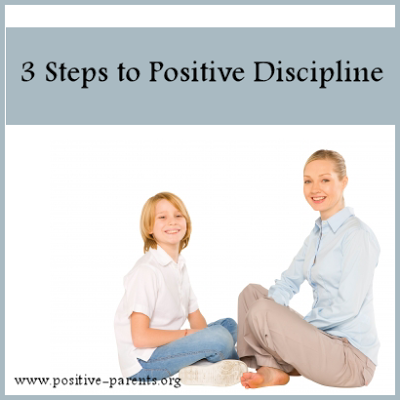
Several years ago, I became frustrated when conventional discipline strategies not only made my son’s behavior more problematic, but also damaged our relationship. I started seeking alternatives, feeling that neither of us were benefiting from my traditional methods, and that’s when I discovered positive discipline.
Today, I’d like to share with you the 3-step process I have used for nearly 6 years now which I has been effective and truly life-changing for my family.
Step One: Assess the Need
I used to think that every misbehavior was nothing more than defiance – a sign that my child was testing his boundaries. Therefore, I felt the need to punish him for his misbehavior every time. This kept us in a terrible cycle for several months. Once I finally understood that misbehavior wasn’t a push against me but rather a signal of an underlying need, I was able to stop punishing and start listening.
An amazing thing happened. Once he actually felt listened to and understood, and once I started helping him instead of punishing him, his behavior improved dramatically.
It isn’t always obvious what the need behind the behavior is, and with toddlers and preschoolers who can’t verbalize their feelings and intentions well, it can be tricky to figure out what is causing the behavior. Even just understanding that there is a reason for it, that they are not just bent on being defiant, helps us to be compassionate and responsive.
If the need behind the behavior is simply hunger or tiredness, meeting that need resolves the problem. If the need is connection or attention, quality one-on-one time will improve behavior. Sometimes the need is to be taught skills so that they can thrive within the boundaries you’ve set for them. Assessing the need is the first step to resolving any behavior problem.
Step Two: Calm Yourself and Your Child
Undisciplined parents cannot effectively discipline children. Put on your own oxygen mask first. Ensure everyone’s safety, then take a moment to breathe. Move from emotionally reactive to cognitively responsive before you deal with the problem at hand. Once you are calm, help your child become calm. Calm brains take in and process information better than dysregulated brains, so wait until everyone’s rational brains prevail before moving forward to solve the issue.
To calm your child, try utilizing a calm-down area . Don’t worry, this won’t reward her for misbehavior. Instead, it teaches her a valuable and much needed life skill – the same one you just used when you disciplined yourself by calming down first – this teaches her self-discipline.
Step Three: Teach and Problem-Solve
The typical go-to methods, such as time out, spanking, and revocation of privileges, are effective in showing the child what they are not allowed to do, but fall short in teaching the child what they can and should do. That’s really the most important part because without knowing better ways to get their needs met, they will continue to use undesirable methods.
...continue reading at CreativeChild

Published on July 23, 2015 11:05
You Blew It. Now What?
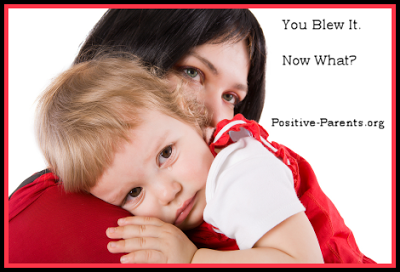
Despite our best efforts to be conscious, positive parents, we humans make mistakes. We’ll never be perfect, and that’s okay for our kids to see, because they’ll never be perfect either. Seeing how you admit mistakes and make amends can be a really great lesson for them.
Mistakes are opportunities to learn and improve, for us and for our children, and maintaining that mindset will prevent us from dwelling with shame. If your parenting performance today was less than stellar, here are 3 steps to repair the relationship with your child.
Admit Your Mistake.
What you can say to your child: “I’m sorry I yelled at you. I lost my cool, and you didn’t deserve that.”
The key here is to not lay blame on the child for your reactions. “I’m sorry I yelled, but you made me so mad” lays the blame on the little one. We are the adults, and our emotional reactions are our responsibility alone.
Some parents don’t want to admit mistakes or apologize for fear of looking weak or like they’re not in authority, but admission and apologizing takes courage. If we want children to own up to their mistakes and make amends for their wrongdoings, we have to set an example of that.
Learn Your Lesson
When we see mistakes as an opportunity to learn and improve, we have to take the learning and improving part seriously! Otherwise, we just excuse ourselves for bad behavior and end up repeating it over and over again. Review the events that led up to your reaction to understand what the trigger was. Once you learn what triggers your negative reactions, you can improve by creating a plan of action for the next time it happens.
Reconnect With Your Child
Rifts in relationships happen. Teaching children how to repair these rifts will help them build meaningful, healthy relationships in the future. Spend some special time with your child laughing and having fun together. Laughter is a connecter. It brings us closer and allows negative feelings to dissipate.
Progress , not perfection, is the goal of a conscious parent. We all fall. It’s what you decide to do once you’re on the ground that defines who you are.
Rise up, make amends, and keep moving.
As seen at Creative Child

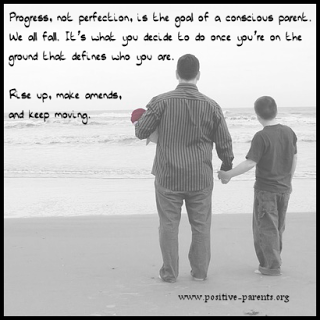
Published on July 23, 2015 10:54
Accept Feelings, Limit Actions

Over the years of moderating a popular parenting page on Facebook , I have had the opportunity to listen to many parents voice their concerns about changing their parenting paradigms to peaceful, positive parenting. One of the major goals of positive parenting is to raise emotionally intelligent children, and this is because research has shown that children with high emotional intelligence are less defiant, mentally healthier, and more successful both academically and in relationships.
Emotional intelligence is the ability to understand, evaluate, and regulate emotions. In our quest to raise emotionally intelligent children, positive parents understand the importance of accepting a child’s feelings. A common misconception is that accepting all feelings means accepting all actions resulting from those feelings, leading to an unruly and disrespectful or spoiled and coddled child.
Feelings are neither right nor wrong. They simply are what they are. We feel what we feel. What we do with those feelings, though, is extremely important, and that is a large part of emotional intelligence. It’s not about just understanding and accepting feelings but also teaching children appropriate actions around those feelings.
Therefore, if we did accept all actions, we wouldn’t be teaching the child how to manage herself during emotional storms or how to respond to others in emotional distress. This wouldn’t grow an emotionally intelligent child but rather an emotionally reactive one. Understanding and validating emotions is only half of the equation.
A common practice in conventional child discipline is to not accept the child’s feelings or actions, but to attempt, instead, to correct both.
In this exchange, the child gets disciplined both for his feelings and his actions:
Parent: Why did you push Tommy down?
Child: He stole my truck!
Parent: It’s just a toy. No need to get angry!
Child: But it’s MINE! Make him give it back.
Parent: You have to learn to share. Go to time-out for pushing Tommy. You know better.
On the other hand, some parents accept both feelings and actions, not correcting either one. This, of course, is permissive and generally doesn’t have a good outcome.
Parent: Why did you push Tommy down?
Child: He stole my truck!
Parent: You’re mad that he took your truck. I understand. That wasn’t nice of him, was it?
Child: No! It’s MINE! Make him give it back.
Parent: Let’s go get your truck back from Tommy.
So, here the child feels validated in his anger, which is good, but he also feels validated in pushing Tommy down. This sends the message that it’s okay to hurt others when you’re upset and doesn’t teach him how to manage his behavior during emotional waves.
When we accept feelings and limit behaviors, we teach children that their emotions are a normal human experience and they are responsible for how their actions surrounding those emotions. Being both accepting and empathetic as well as firm and decisive is the essence of positive parenting. Let’s see how that plays out with the same scenario.
Parent: Why did you push Tommy down?
Child: He stole my truck!
Parent: You’re mad. I get it; however, I won’t let you push people down. Come and sit with me until you’re calm.
Child: But it’s MINE! Make him give it back!
Parent: I want you to sit with me now. We will get the truck when you’re not angry.
Employ a time-in until child’s anger has subsided. There are many things to do to teach a child how to regulate his emotions, from deep breaths, coloring, hugs, visualization, and jumping jacks. Different things work for different children, and you will know what calms down your child.
The discipline comes after the storm passes.
Parent: You did great at calming down! Look at Tommy’s face. How do you think he’s feeling? How do you think you would feel if you were pushed down? (Teaching a child to put himself in another’s place encourages empathy). How can you make him feel better and get your truck back?
Child: I don’t know.
Parent: When someone hurts me, I feel better when they apologize. Do you think that would help Tommy? (Forced apologies don’t hold much weight, but I always suggest it in teaching my child how to repair relationships. I’ve found they always choose some way to say they are sorry, especially when they’re not forced to say it but instead we have focused on empathy for others.)
Child: I guess so, but I want my truck!
Parent: Use your words and ask him. I would say, “Tommy, I’m sorry I pushed you down. I want my truck back, please.” How does that sound to you?
When we don’t accept feelings, we inadvertently cause children to feel frustrated and possibly think there is something wrong with them because of how they feel. This almost certainly leads to more negative behavior and possibly a negative self-concept as well.
When we accept all feelings and actions, we don’t teach them how to manage themselves, and people who act impulsively on their wide range of emotions don’t fare well in life. Accepting feelings and limiting behaviors teaches that emotions are normal but that we have a responsibility to manage ourselves well, and this is the best way to raise emotionally intelligent children.
As seen at CreativeChild

Published on July 23, 2015 10:32
The Toxic Effects of Shaming Children
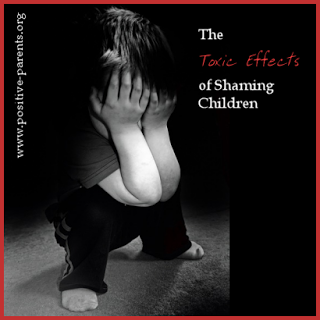
Shame has long been wielded as a powerful tool to modify a child’s behavior. When made to feel unworthy, children will usually try harder to please their parents, giving the illusion that it’s “working,” but those feelings of worthlessness cause deep scars which can take a lifetime to heal.
Shame isn’t only common in abusive homes, but is generally an acceptable form of “discipline” in your average “nice” family. Shaming includes verbal comments such as “stop acting like a baby,” “you naughty child,” and “are you that stupid?” as well as the unfortunate trend in public shaming and social media humiliation.
The Developing Self-Concept
Self-concept is the image we hold of ourselves – of our abilities, our nature, qualities, and typical behavior. This is formed in our earliest years by what we hear about ourselves through those closest to us. In essence, children come to see themselves the way their parents and caregivers see them. Therefore, when they consistently get the message that they are “bad,” “naughty,” or “stupid” or that they “act like a baby,” that message is internalized.
Because self-concept determines behavior, children will act out how they feel inside. A child who believes himself to be bad will, therefore, exhibit bad behavior, often causing the parent to pile on more shame in an effort to control it. The cycle perpetuates.
The Easy Way Out
We have a habit of reducing children to nothing more than behavior, and we treat only the behavior we see rather than treating the human being behind the behavior. When we are focused on only treating behavior, we may be quick to dole out punishments or use shaming tactics to gain compliance. When we are focused on treating the human being, we are able to empathize, teach, and guide the child to better behavior. This is obviously a healthier approach, but it takes more time and effort.
Shaming is quick and often effective, so don’t be fooled into taking the easy way out. There is a valuable, worthy human being behind that behavior.
The Cost of Shame
Shame doesn’t diminish behavior; it diminishes the self. This may, in turn, affect behavior, but at what cost? According to Good Children – At What Price? The Secret Cost of Shame by Robin Grille and Beth McGregor, numerous studies link shame with the desire to punish others.
Shamed individuals are more likely to be aggressive and exhibit self-destructive behavior. Shame causes people to withdraw from relationships, to become isolated, and they compensate for deep feelings of shame with attitudes of superiority, bullying, self-deprecation, or obsessive perfectionism. When shame has been severe, it can contribute to mental illness.
Instead of Shaming
There are plenty of ways to teach children without attacking or humiliating them.
Discipline through play . During play, children’s brains are very receptive. This is an opportune time to teach boundaries and appropriate behavior.
Try these alternatives to punishment. They work!
Give consequences that teach, not shame. Allow natural consequences when appropriate and utilize problem-solving skills to determine what the child needs to be taught in order to do better. If a consequence is necessary, it should be related and delivered with the intent to teach, not to make the child feel bad about himself.
Discipline with connection in mind. Understanding that calm, connected children absorb information best is important to changing from a punitive mindset to connection-based discipline .Join the Movement to End Child Shaming
A group of advocates have created a call to action to stop the shaming of children. Every voice counts, and children need your voice. Please visit www.stopshamingkids.com and sign the petition to end shaming on social media. Our children deserve our protection. In order to raise emotionally healthy people, we must stop shaming now.
Reference: http://our-emotional-health.com/articles/shame.pdf
As seen at CreativeChild


Published on July 23, 2015 10:26
3 Simple Steps to Effective Parenting
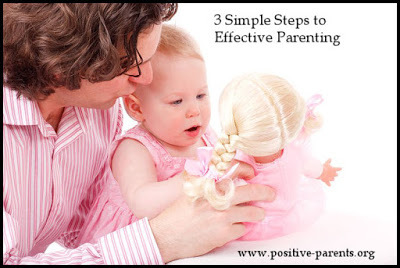
Has parenting lost its joy? Does the end of the day find you overwhelmed, upset, or disappointed at the outcome yet again? I totally get it! I was there, too! Thankfully, I discovered three terrific secrets to effective parenting. It’s not easy, but it works. If you want to get back your joy and go to bed at night feeling good about your day, try these.
Step One: Be Calm
You’re thinking yeah, right! In this chaos?! Hear me out, though.
Your brain really loves repetitiveness. Every time you lose your cool, you’re strengthening a little pathway in your brain that makes you more likely to lose your cool again and again. Eventually, it doesn’t take much to set you off. When your fuse is only about 3 centimeters long, it’s pretty difficult to live in joy, for both you and your family!
If you’ve developed a yelling habit , it’s not too late to stop.
How?
Disarm the triggers that light your fuse by keeping track of them for a few days to notice your patterns. Intentionally plan a response to each trigger so you don’t go to your default reaction. Then, the next time you feel the agitation rising, embrace that tiny space that occurs between the initial trigger and your reaction, expand that space with a few deep breaths and a helpful mantra, and then remember your planned response.
This isn’t easy, but each time you calm yourself down and respond with a rational mind, you’re strengthening a new pathway that will help you be a more effective parent. As a bonus, when you remain calm during emotional upset, you model an extremely valuable skill for your child. As a result of seeing you master it, they are more likely to be able to calm themselves as well. Plus, your kids aren’t listening when you’re freaking out on them. It triggers their lower brain, too. (That’s the part that makes us flip out.) Calm minds equal rational responses.
Step Two: Be Confident
The messages you get on what “good parenting” looks like is often contradictory. The “should” and “should nots” are coming at you from all angles, and it can be difficult to feel confident that you’re making the right choices. Truthfully, you probably are, and if you’re not, your gut will tell you.
The trick is learning to tune out all the clamor so you can tune in to your intuition. Children feel secure with a parent who is both calm and confident, so have faith in yourself. You don’t have to be perfect; just show up and do your best each day.
There are two key ways to show confidence. One is to be calm, which we just discussed, and the second is being consistent, which we are going to talk about next.
Step Three: Be Consistent
...continue reading at Creative Child.

Published on July 23, 2015 10:21
Discipline Through Play
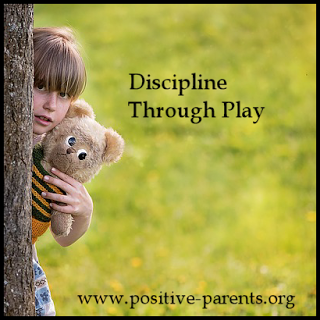
Discipline doesn't mean to punish. The root word, disciple, means to teach. Rather than focusing on busting bad behavior, it is more effective to teach what is acceptable. There are many ways to teach a child, and I have found that teaching through play has a big impact.
We are aware that play is vital to childhood. Children learn openly through play. Their brains are engaged, receptive, and absorbing everything. Play offers a wonderful opportunity to not only connect with your child, but to teach valuable lessons.
Here are some ideas to teach through play:
Games Card and board games are fantastic ways to teach children patience, manners, and fair play. Take it one step further by creating your own game. Create a manners game by using two shoe boxes (a good manners box and a bad manners box) and several laminated stars. On the stars, write good manners such as “saying please” or “holding the door open for someone” and bad manners “chewing with your mouth open” or “snatching toys”. Have the child choose a star and decide which box to drop it into.
Puppet Shows Puppet shows do not have to be a big production. Make sock puppets and use the puppets to act out a scene and teach a lesson, such as what to do when someone hurts your feelings or how to make a new friend. This can also be done with toys. You can use bears, dolls, or whatever you’d like and act out different scenes. This is also a great outlet for your child as children enjoy creating their own shows.
Role Playing Ask your child to dress up and take on different roles, such as waiter, teacher, or grandparent. You, playing the role of the child, demonstrate how to behave in a restaurant, sit quietly in a class, show gratitude when opening presents, or whatever you feel your child needs to practice. Then switch roles and let your child practice these important skills. Remember to keep it lighthearted and fun. Silly costumes are a bonus!
Story-telling There are lots of children's books that teach morals and manners, and those are wonderful tools, but making up stories gives you an opportunity to address a recent problem or issue your child has faced. With a bit of creativity, story-telling is a wonderful way to teach cause and effect. Be sure to add in humor! Research suggests that laughter produces psychological and physiological benefits that help children learn.
Meeting children in their imaginative worlds is both a magical and practical way to teach them the lessons we want them to learn. A world of possibilities open up when we step inside the playful world of a child. What will you playfully teach today?
As seen at Creative Child.

Published on July 23, 2015 10:11
10 Tips for Well-Behaved Kids and Happy Parents by Amy McCready
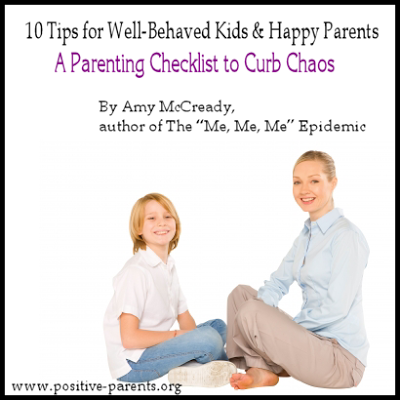
10 Tips for Well-Behaved Kids & Happy ParentsA Parenting Checklist to Curb Chaos
By Amy McCready, author of The “Me, Me, Me” Epidemic
Are you one of “us”? You know, the parents who make endless to-do lists in an attempt to make our chaotic lives just a little moremanageable? Life with kids is certain to include curveballs so having a “parenting to-do list” can keep things from getting out of hand and actually improve your kids’ behavior! (How’s that for a win-win?) Here are ten simple to-do items for raising well-behaved kids and keeping parenting burn-out at bay.
1. Make daily investments. The number one thing you can do to raise happy, cooperative, even joyful kids is invest in one-on-one time with them every day. Here’s why: kids are hard-wired to want and need positive attention from you. And when they don’t get that in positive ways? They will seriously act out in negative ways – because to them, attention is attention. My favorite tool to give kids what they want and need most (your attention and a sense of belonging) while simultaneously preventing tantrums, sibling fighting, whining and more is called Mind, Body and Soul Time.Here’s how it works: Set aside 10-15 minutes, once or twice a day to spend with your child one-on-one with NO distractions. No phones, no checking email, no multi-tasking. This is a time to be completely present doing whatever your child loves to do. Think reading books, coloring, playing dress-up, or swinging on a swing. The key is to make it all about them. When you invest the one-on-one time, you give them the gifts of feeling loved, safe, secure, and valued. And, you’ll get that investment of time back 10-fold in good behavior!
2. Hit the Snooze Button. In other words…get serious about sleep. When we’re overtired we’re irritable, cranky, and sometimes even feel ill. It’s the same for kids. In fact, most kids need MORE sleep than they’re getting because their bodies are growing at such a rapid clip. Talk to your pediatrician about how much sleep your child really needs by age. If your child has a sleep deficit, try moving up bedtime by 10 minutes every few nights. When kids are well rested, they’ll be better behaved, be more attentive in school, and be A LOT more fun to be around!
3. Make Routines Rule. When it comes to managing the most challenging parts of your day like mornings, mealtimes, bedtimes and after school – routines are your best friends. Kids thrive on them – and they help make everything run a whole lot smoother. Let your kids help decide how the routine will go (do we get dressed or brush teeth first? How can you help get dinner ready?) For little ones, write out the order of the routine using pictures or words and let them decorate it and hang it where they’ll see it every day. Then – help them (and you) stick to it.
4. Get Everyone to Be ALL-IN. The best run households with the most time for fun are those in which EVERYONE – from parents right on down to toddlers – contribute to the household responsibilities. You are a team. Not parents vs. kids. Not parents do it all. All kids, from toddlers to teens, should have “family contributions” (not “chores!”) that they do daily. This helps bring your family closer together, teaches kids important life skills and works to prevent the entitlement epidemic.
5. Refuse to Referee. As tough as it is to not jump into the middle of every sibling squabble, the reality is we parents often make things worse when we intervene. When we play referee, assess blame and dole out punishments, we set our kids up to see winners and losers – and a reason to escalate sibling rivalry. Instead, encourage your kids to find a resolution and even common ground on their own. If things are escalating out of control and you have to get involved, don’t choose sides, but ask questions to help them figure out a solution that all parties can feel good about. By refusing to referee and setting your sights on SOLUTIONS, you’ll go a long way in preparing them to resolve conflict throughout their lives.
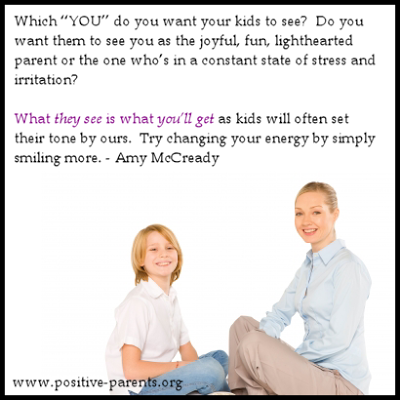 6. Keep it Simple. That’s good advice for most aspects of life, right? When it comes to family “rules and regulations,” simple is always better. Kids get overwhelmed with too many rules and consequences. Determine the most important issues for your family and clearly communicate the expectations – without being overly complicated. Be sure to reveal consequences in advance and then stand firm. Kids want and need firm and loving limits.
6. Keep it Simple. That’s good advice for most aspects of life, right? When it comes to family “rules and regulations,” simple is always better. Kids get overwhelmed with too many rules and consequences. Determine the most important issues for your family and clearly communicate the expectations – without being overly complicated. Be sure to reveal consequences in advance and then stand firm. Kids want and need firm and loving limits. 7. Take a Time Out from the Time-Out. “That’s it, you’re in time-out!” How many parents have uttered that phrase over and over and have been frustrated because it doesn’t work to actually change behavior? Why? Because sitting in a corner or on a time-out chair doesn’t help kids understand how to make better choices. It doesn’t teach them how to do anything differently next time. And for most strong willed kids, time-outs are the training grounds for serious push-back. Instead, focus on training, not punishment. Ask, “What can we do differently next time?” and role play the do-over.
8. Say No to NO. Kids – especially the young ones - are all about the questions. All day. Every day. And more often than not, our go-to answer is “no”. It’s usually for good reason (it’s midnight and the park is closed); but kids get frustrated with a constant stream of no’s. Not to mention that too many no’s creates a situation ripe for a power struggle. Look for opportunities to say “yes” when you can. If your child wants to go to a movie and it’s not convenient right then, try, “Hey, a movie sounds like fun! Should we go Friday after daycare or on Saturday afternoon?” Will there be times when the answer is a big “no”? Sure, but the more yes’s we can sprinkle in to the mix, the more palatable the no’s will seem to our kids!
9. Watch your energy. Which “YOU” do you want your kids to see? Do you want them to see you as the joyful, fun, lighthearted parent or the one who’s in a constant state of stress and irritation? What they see is what you’ll getas kids will often set their tone by ours. Try changing your energy by simply smiling more. It will help you remain calm in times of stress, and your kids will notice and keep their behavior more positive as well.
10. Consider the Source. Misbehavior is always telling us something. For example, if Jacob keeps pestering you at your desk, could it be that you’ve been there all day and he needs a little Mind, Body and Soul Time? Or, if Kayla throws a royal fit about wearing the RED shoes that totally don’t go with her outfit – perhaps she really wants to make her own choices and feel independent? Before you get worked up about a particular misbehavior, consider what the child is trying to tell you so you can focus on SOLUTIONS to solve the problem. You’ll all feel a lot better for it!
Keep these ten tips handy to bring out the best in your kids and keep parenting chaos at bay!
You can learn more about curbing entitlement and chaos while encouraging cooperation by picking up a copy of Amy’s new book, The “Me, Me, Me” Epidemic: A Step-by-Step Guide to Raising Capable, Grateful Kids in an Over-Entitled World . Available August 11, 2015 wherever books are sold.
Get FREE COACHING with Amy McCready when you pre-order The “Me, Me, Me” Epidemic. Learn more at www.AmyMcCready.com .
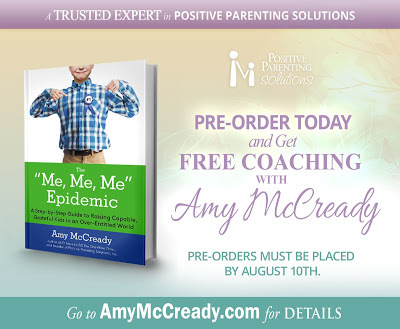
Published on July 23, 2015 09:43
July 11, 2015
Emotions Coaching - The Heart of Parenting

I'm teaming up with The Gottman Institute to give away 3 copies of the Emotion Coaching series!
Emotion Coaching: The Heart of Parenting presents a 5-step method that builds emotional intelligence and creates positive, long lasting effects for children. Easy to learn, and used by parents, educators and care-givers, it supports kids through life’s ups and downs in a way that builds confidence and helps them grow socially, emotionally and intellectually.
Researchers have found that even more than IQ, your emotional awareness and ability to handle feelings will determine your success and happiness in all walks of life. Acclaimed researchers and therapists Drs. John and Julie Gottman present this proven program to show you how to be there for your child when it really counts.
Learn the best ways to respond when your child is sad, angry, or scared Discover how to use emotions as opportunities for connection and teaching Learn how to set clear, consistent limits while helping your child problem-solve This 2.5 hour video program teaches parents, educators, and caregivers how to Emotion Coach children in 5 simple steps. By increasing emotional awareness and communication skills, this program improves your emotional responsiveness and, in turn, creates emotionally intelligent children. Recorded before a live audience in Seattle, the videos are divided into 6 chapters that each contain an informative discussion from Drs. John and Julie Gottman, along with invaluable “Try This” exercises that are outlined in the accompanying parent workbook. After completing the program you’ll have a good understanding of what emotional intelligence is, why it’s important, and how to use the 5 key steps to help establish a solid emotional foundation for your child.
$99 value! Enter below for your chance to win!
a Rafflecopter giveaway
Learn all about the program HERE.

About The Gottman InstituteThe work of The Gottman Institute is based on the distinguished research and clinical methodology of Dr. John Gottman and Dr. Julie Schwartz Gottman. Our mission is to create great relationships and to help repair troubled ones, using an acclaimed blend of science and practical therapy. From a global network of Gottman-trained therapists to a wide selection of workshops, our programs and products strengthen couples, support new parents, and guide those seeking to “emotion coach” their children. The Institute teaches educators and facilitators how to lead Gottman-themed workshops, and can arrange in-house professional training for organizations and staff members. Visit www.gottman.com for more information
Published on July 11, 2015 07:20
June 25, 2015
The Message Behind "Be Good" and What to Say Instead
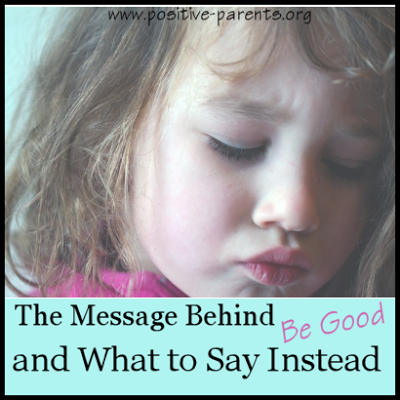
I hear parents all the time pleading with and warning their children to “be good.” This common phrase has escaped my lips a few times, too. There are a couple of reasons why I’ve decided to drop this phrase for good.
“Be Good” is Too Vague
Children aren’t mind readers. It’s much more helpful to give them specific instructions than to assume they know exactly what we mean by “be good.” It’s a very abstract concept for children, even if we think they should know what behavior we expect.
Instead of saying “be good,” try:
“When you’re at grandma’s, I want you to pick up your toys when you’re finished playing and listen when she asks you to do something.”
“At the store, you may help me push the cart or walk beside it. You may not run in the aisles or ask for a toy today.”
“In the movie theater, be quiet while the movie is playing and don’t put your feet on the seats.”
“Be good…because usually you’re not.”
I wonder if this isn’t the underlying message that children pick up on when this phrase is overused. I always try to put myself in my child’s shoes. I think hearing “be good” all the time would make me feel like perhaps my parent doesn’t think I’m a good person. If I was, I wouldn’t need the constant reminder, right?
What if my husband told me to “be good today” before he left for work? How would that make me feel? What is the message I would get from it?
I believe one of the most important things we can do for our children is to believe in them, and show our faith in their goodness, abilities, and positive intentions. Here is a huge lesson I’ve learned - When children feel good, they will be good, and knowing that we believe the best of them is one way to build their self-esteem and help them feel good.
...continue reading at Creative Child

Published on June 25, 2015 09:02
Does Time-In Reward Children?

Time-out didn’t work in my home. I followed the “rules”. I placed my son in time-out for one minute per each year of his age. I did not engage with him other than to replace him back in time-out during his punishment. Once he had served his time, I asked him what he had done wrong that got him placed in time-out, and once he repeated it back to me, we moved on with our day – until the next time-out which was never too far away.
If it ever did stop one poor behavior, another cropped up right in its place. His behavior got worse, his spirit grew dim, and the disconnection between us was widening. That is why I began to seek out alternatives. After my paradigm shift to positive parenting, I found time-in to be an effective tool to both connect with my child and redirect his behavior.
The paradigm shift was an important step to allowing me to see my child through a new lens. When I practiced traditional parenting, I saw every “misbehavior” as an infraction that needed to be addressed and squashed immediately, lest he get “out of hand.” I bought into the idea that children were seeking control and would take over the house and try to rule over me if I didn’t maintain strict authority. Indeed, that was a very sad way to view my child.
Through study of child development and even more so through stopping to look into my son’s eyes when he was upset, I came to adopt a much different view of my child, of all children. I see “out of sync behavior” as a call for help, a clue that the internal state of a child is off balance and needs addressed. I saw that he was a good person and wanted to do good things. He wanted to please us and be connected. He wanted to know he was valued and where he fit in. Once I saw my child differently, it was easy to relate with him differently.
This difference in the positive parenting view of children from the traditional view became clear to me when a comment was made on my previous article, 3 Alternatives to Time Out That Work . This person believed that the practice of time-in would cause the child to misbehave to get the “reward” of parental attention. It’s true that children do crave attention and connection, and I suppose if the only way a child can get it is through poor behavior, she will resort to that. But how is this the child’s fault?
If attention and love is only given during a time-in, there is something fundamentally wrong in the relationship dynamic in the first place. Children should be given lots of positive attention and affection every day, and if we are doing that, there will never be a need to “misbehave to get attention.”
Furthermore, if we are already close and connected with that child, then the time-in allows them to focus on our instructions rather than being defensive against us. Bringing a child into safe and loving arms to help him calm down and learn to manage himself through emotional storms is not coddling or rewarding, it’s teaching. Isn’t that what parenting is?
I think, culturally, we need to move past the idea that too much love rewards or spoils children. This idea damages our relationships and leads us to treat unfairly those who are newest among us. Children do not enter the world with bad intentions. They do not come to wear us out, test our limits, or seek control. They come with a need for love and guidance.
In 5 years of practicing positive parenting, I have never found that love drives misbehavior, but that the opposite true. Love allows them to grow into their full potential.
As seen on CreativeChild

Read more here for Positive Parenting Tips from Rebecca Eanes!
Published on June 25, 2015 08:52



